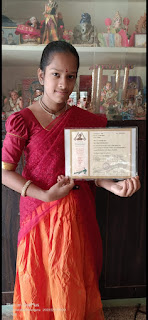BALANTRAPUVARI BHAKTITATWAM-బాలాంత్రపువారి భక్తితత్త్వం
This Blog contains bhakti samkirtanas and kirtanas in different views..
Saturday, 23 December 2023
Tuesday, 21 November 2023
GURUKULAM, Music classes
🙏 GURUKULAM..
carnatic music classes
Annamayya ,tyagaraja,ramadasa etc samkirtanam classes and carnatic music classes are conducting..
University certificate also provided by appearing exam.
The fee will be spent for poor students educational expenses 🙏
Interested people can contact me through WhatsApp 7718001759 🙏
Saturday, 22 July 2023
CARNATIC MUSIC
ABOUT CARNATIC MUSIC:
Carnatic music, known as Karnāṭaka saṃgīta or Karnāṭaka saṅgītam in the South Indian languages, is a system of music commonly associated with South India, including the modern Indian states of Karnataka, Andhra Pradesh, Telangana, Kerala and Tamil Nadu. It is one of two main subgenres of Indian classical music that evolved from ancient Hindu texts and traditions, particularly the Samaveda. The other subgenre being Hindustani music, which emerged as a distinct form because of Persian or Islamic influences from Northern India. The main emphasis in Carnatic music is on vocal music; most compositions are written to be sung, and even when played on instruments, they are meant to be performed in gāyaki (singing) style.
Carnatic music is based in South India (the red region).
Although there are stylistic differences, the basic elements of śruti (the relative musical pitch), svara (the musical sound of a single note), rāga (the mode or melodic formulæ), and tala (the rhythmic cycles) form the foundation of improvisation and composition in both Carnatic and Hindustani music. Although improvisation plays an important role, Carnatic music is mainly sung through compositions, especially the kriti (or kirtanam) – a form developed between the 14th and 20th centuries by composers such as Purandara Dasa and the Trinity of Carnatic music. Carnatic music is also usually taught and learned through compositions.[2][3] Most Carnatic compositions are in Kannada, Sanskrit, Tamil and Telugu.
Carnatic music is usually performed by a small ensemble of musicians, consisting of a principal performer (usually a vocalist), a melodic accompaniment (usually a violin), a rhythm accompaniment (usually a mridangam), and a tambura, which acts as a drone throughout the performance. Other typical instruments used in performances may include the ghatam, kanjira, morsing, venu flute, veena, and chitraveena. The greatest concentration of Carnatic musicians is to be found in the city of Chennai. Various Carnatic music festivals are held throughout India and abroad, including the Madras Music Season, which has been considered to be one of the world's largest cultural events.
Origin and history
Nature
Important elements
Improvisation
Compositions
Prominent composers
Wednesday, 24 November 2021
Carnatic music classes
దేవుడినైనా మెప్పించేది..
పసిబిడ్డను లాలించేది...
మనసును మురిపించేది..
ఎన్నో శారీరిక మానసిక రుగ్మతలను నయం చేసేది..
ఇంకా ఇలా ఎన్నో..అసాధ్యం కూడా సాధ్యం చేసేది మన సంగీతం
మన మాటలో కూడా సంగీతం..
MUSIC MAKES MIRACLES..
B v s Rama kumari is taking online and offline classes of Carnatic music with bhajans, annamayya kirtanas etc. along with university certificate.
Interested people
Feel free to contact..
What's app call.
7718001759
.
All fees are collexting for talented poor students education expenses.
Build yours and child's pleasant future..🎼🎼🎼🎼🎼🎼🎼🎼🎼🎼🎼🎼🎼🎼
రండి నేర్చుకుందాం సంగీతం .
కాపాడుకుందాం..
ముందు తరాలకు అందిద్దాం ..మన ప్రాచీన సంప్రదాయం..
సంప్రదించండి
రమాకుమారి బాలాంత్రపు
7718001759
నోట్ :- మీరు చెల్లించే రుసుము పేద విద్యార్థుల శిక్షణ కు వినియోగించ బడును🙏
Thursday, 21 May 2015
ANNAMAYYA SAMKIRTANALU---- LAKSHMI NARASIMHA
chittaja gurudaa O
చిత్తజగరుడ శ్రీనరసింహ |
బత్తి సేసేరు మునులు పరికించవయ్య ||
చ|| సకలదేవతలును జయవెట్టు చున్నారు |
చకితులై దనవులు సమసిరదె |
అకలంకయగు లక్ష్మి అటు నీతొడపై నెక్కె |
ప్రకటమైన నీకోపము మానవయ్య ||
చ|| తుంబురు నారదులు దొరకొని పాడేరు |
అంబుజాసనుండభయమ డిగీనదె |
అంబరవీధి నాడేరు అచర లందరు గూడి |
శంబరరిపు జనక శాంతము చూపవయ్యా ||
చ|| హత్తి కొలిచేరదె యక్షులును గంధర్వులు |
చిత్తగించు పొగడేరు సిద్ధ సాధ్యులు |
సత్తుగ నీ దాసులము శరణుజొచ్చితిమిదె |
ఇత్తల శ్రీవేంకటేశ ఏలు కొనవయ ||
cittajagaruDa SrInarasiMha |
batti sEsEru munulu parikiMcavayya ||
ca|| sakaladEvatalunu jayaveTTu cunnAru |
cakitulai danavulu samasirade |
akalaMkayagu lakShmi aTu nItoDapai nekke |
prakaTamaina nIkOpamu mAnavayya ||
ca|| tuMburu nAradulu dorakoni pADEru |
aMbujAsanuMDaBayama DigInade |
aMbaravIdhi nADEru acara laMdaru gUDi |
SaMbararipu janaka SAMtamu cUpavayyA ||
ca|| hatti kolicErade yakShulunu gaMdharvulu |
cittagiMcu pogaDEru siddha sAdhyulu |
sattuga nI dAsulamu SaraNujoccitimide |
ittala SrIvEMkaTESa Elu konavaya ||
Wednesday, 14 May 2014
ANNAMAYYA STUTI
Saturday, 13 July 2013
ANNAMAYYA SAMKIRTANALU--TATWAMULU

G.N.NAIDU
అడుగరె యీ మాట అతని మీరందరును
యెడయని చోటను యిగిరించు ప్రియము
పొరపొచ్చమగుచోట పొసగవు మాతలు
గరిమ నొరసితేను కలగు మతి
సరవులు లేనిచోట చలము వెగ్గళమౌను
నొరసి పెనగేచోట నుమ్మగిలు వలపు
వొలసినొల్లనిచోట వొనరవు నగవులు
బలిమి చేసేటిచోట పంతము రాదు
అలుకచూపేచోట అమరదు వినయము
చలివాసి వుండేచోట చండిపడు పనులు
ననుపులేనిచోట నమ్మిక చాలదు పొందు-
అనుమానమైనచోట నంటదు రతి
యెనసినాడు శ్రీవేంకటేశుడు నన్నింతలోనే
తనివిలేనిచోట దైవారు కొర్కులు
adugare yee maaTa atani mIramdarunu
yeDayani chOTanu yigirimchu priyamu
porapochchamaguchOTa posagavu maatalu
garima norasitEnu kalagu mati
saravulu lEnichOTa chalamu veggaLamounu
norasi penagEchOTa nummagilu valapu
volasinollanichOTa vonaravu nagavulu
balimi chEsETichOTa pamtamu raadu
alukacoopEchOTa amaradu vinayamu
chalivaasi vumDEchOTa chaMDipaDu panulu
nanupulEnichOTa nammika chaaladu pomdu-
anumaanamainachOTa namTadu rati
yenasinaaDu SrIvEmkaTESuDu nannimtalOnE
tanivilEnichOTa daivaaru korkulu



